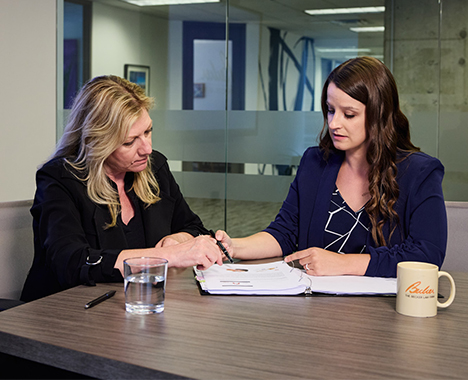Shoulder dystocia is a frightening and serious complication that can occur during labor or birth, in which the head of the fetus has been cleared but the shoulders are stuck on the way through the birth canal. Shoulder dystocia can harm both mother and baby, with the mother possibly suffering from a hemorrhage and uterine rupture. Even experienced doctors sometimes react incorrectly out of panic when the problem occurs, causing harm to the child and mother.
As a patient, you have the right to expect a high standard of care from your nurses and your physician or midwife during the birth of your child. However, medical professionals sometimes fail to provide mothers and their unborn or newborn babies with a professional standard of care. As a result, serious birth injuries or even wrongful death of the mother or infant can occur.
The Becker Law Firm has successfully obtained compensation for families when doctors or other medical professionals failed to provide adequate care at birth. We want to help you, too. Contact us online or call 216-621-3000 for a free consultation with one of our shoulder dystocia lawyers in Ohio.
Filing a Lawsuit for Shoulder Dystocia Negligence
Obstetricians and hospitals vigorously defend shoulder dystocia lawsuits, but our team of skilled medical malpractice lawyers knows what to look for in these types of cases. We understand the mechanics of shoulder dystocia maneuvers (none of which requires touching the baby’s head) that must be adhered to during delivery in order for doctors to meet the standard of care.
Important evidence to use at trial includes:
- Medical records from labor and delivery
- Pictures/video taken by family members
- Testimony from friends and family members who saw how the doctors and nurses reacted to the shoulder dystocia emergency
In particular, anything that the doctors and nurses said during the delivery can be important to show that they understood the emergency and to show how they dealt with it.
Common Injuries Caused by Improper Management of Shoulder Dystocia
Shoulder dystocia leads to brachial plexus injuries. The brachial plexus is a complex set of important nerves that exit the spinal cord at the level of the neck, extend through the shoulder into the armpit, and go down the arm and into the fingertips. The brachial plexus nerve network covers the C5-T1 region of the neck. There is a brachial plexus on each side of the neck.
There are four types of injuries caused by shoulder dystocia:
- Erb’s palsy: The first type of brachial plexus injury, Erb’s palsy is an injury to the upper nerves that lead from the spinal cord. Children with Erb’s palsy have full or partial paralysis of the arm.
- Klumpke’s palsy: Klumpke’s palsy is an injury to the lower nerves that lead from the spinal cord. Children with Klumpke’s palsy have paralyzed forearms and hands.
- Developmental delays: When shoulder dystocia causes prolonged lack of oxygen, a child may lose important brain cells and may suffer from developmental delays.
- Cerebral palsy: Lack of oxygen caused by shoulder dystocia can also cause cerebral palsy.
Each case is different, and the severity of the injury is often determined by the damage done to the baby's nerves or brain. Treatment for brachial plexus injuries can include physical therapy and possibly surgery. If you believe the use of excessive force or negligence by a healthcare provider may have caused your infant’s injuries, contact The Becker Law Firm to discuss your options.
Risk Factors for Shoulder Dystocia
Shoulder dystocia may be more common in cases involving:
- A large baby, a small pelvis, or short maternal stature. A baby over 8 pounds and 13 ounces has an increased chance of shoulder dystocia. Likewise, a mother with a small pelvis or a short stature is at increased risk of experiencing shoulder dystocia during delivery.
- Excessive weight gain or gestational diabetes. Weight gain of more than 30 pounds and gestational diabetes corresponds to larger baby size and a higher risk of shoulder dystocia.
- A prior delivery with shoulder dystocia or brachial plexus injury. A prior delivery with complications increases the risk of shoulder dystocia and brachial plexus injury. Cesarean section should be used in subsequent deliveries to avoid similar complications.
- Slow dilation or progression during labor. Any abnormalities in dilation or descent indicate the baby is a tight fit and at a heightened risk of shoulder dystocia.
- Use of forceps or vacuum extractor. These instruments do not shift the baby’s position in the birth canal. As a result, the use of forceps or a vacuum can interfere with the delivery process by pulling the baby straight down and increase the chance of shoulder dystocia.
What Doctors Can Do to Prevent Shoulder Dystocia Injuries
Doctors encountering shoulder dystocia must react quickly. The baby’s shoulder is lodged behind the mother’s pubic bone but the head is through the birth canal.
This partial delivery does not stop the powerful contractions, which put pressure on the baby (often on their neck) and the umbilical cord while the baby is stuck. If the baby is not delivered in the next few minutes, a lack of oxygen to the brain will begin to cause permanent injuries.
There are a series of maneuvers that obstetricians and the delivery team must perform when they encounter shoulder dystocia in order to prevent injury to the mother or child:
- McRoberts maneuver: bending the mother’s legs up to her chest
- Suprapubic pressure: pushing down on the mother’s stomach at a forty-five-degree angle
- Woods/Rubens maneuver: rotating the baby from inside the birth canal
- Episiotomy: cutting the area between the vagina and the anus to provide more room
- Zavenelli maneuver: pushing the baby back into the vagina and performing a C-section
- Symphysiotomy: surgically cutting the mother’s pubic bone to allow more room
Shoulder dystocia has been studied for hundreds of years, and through research, trial and error, and investigation, doctors now know the correct methods to properly and safely dislodge the baby’s shoulder. These tried and true methods are taught in medical school and at continuing education seminars. With proper attention, children should not have to suffer injuries.
If your child was injured as a result of improper management of shoulder dystocia during birth, contact us online or call 216-621-3000 for a free consultation with one of our shoulder dystocia attorneys in Ohio.



